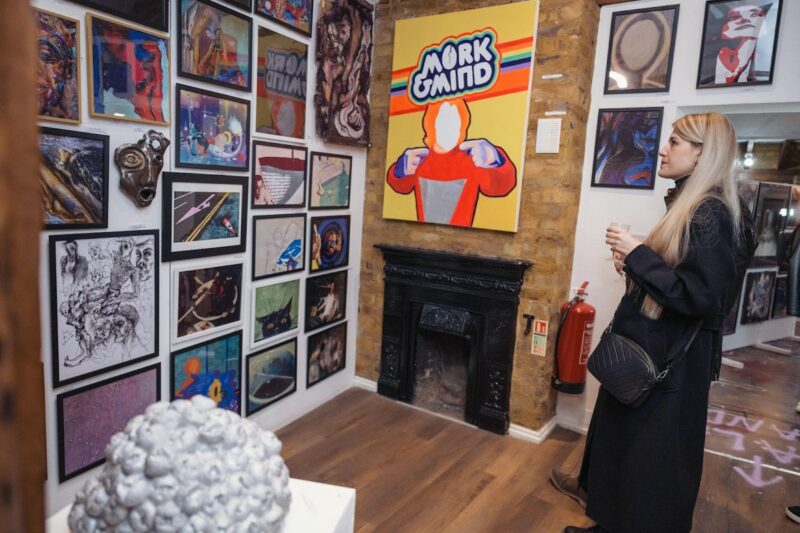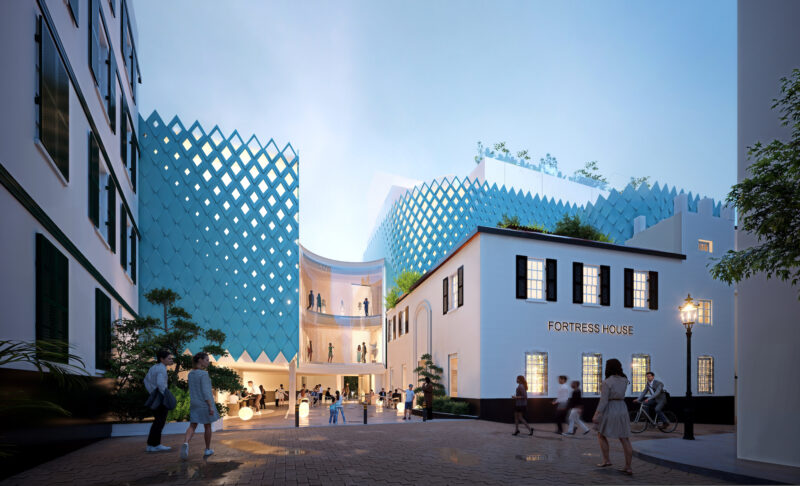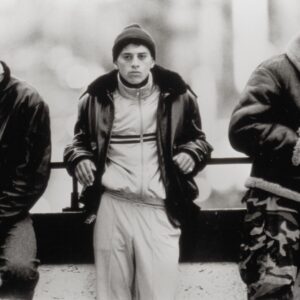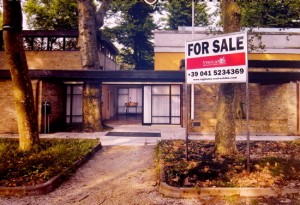
The Venice Biennale is the most unique thing in the art world. At least it’s supposed to be. Lately, I’m having a hard time distinguishing biennales, art fairs and museum shows so I’ve come up with a rule of thumb: Art fairs tell us what is going on in the art world today, museums tell us what happened yesterday, and biennales should tell us what to look for tomorrow. So when I read Venice Biennale curator Daniel Birnbaum’s essay “Fare Mondi // Making Worlds” I was a bit confused. Birnbaum opens his essay pontificating on what art is (not a joke). He actually opens with this sentence: “A work of art is more than an object, more than a commodity. It represents a vision of the world, and if taken seriously must be seen as a way of ‘making a world’.” Thanks for the tip, Dan.
From Giotto to Serra, I think nearly every exhibition or catalog I’ve ever seen has addressed Birnbaum’s theme in some way, shape or form. It’s one of the first points of reference for any art review, and a key underpinning of the contemporary art movement – the focus on process, the “why was this made” question that helps us try and see things from the artist’s perspective.
At best, it’s a theme for today, at worst, the same tired question we saw yesterday in each and every opening, retrospective and exhibition. By sticking to this canonized perspective, Birnbaum has backed very far away from the edge and played it safe. In taking such an extremely conservative curatorial frame this year’s exhibition stunts the possibility of looking forward by tying us to the age old conversation we have every year. But by no means am I saying that the Venice Biennale showcases a disappointing collection of art. It’s not. It is a disappointing moment for Birnbaum and a missed opportunity for one man to share a unique vision of where art is going and what great potentials it could realize.
The stale and loquacious exhibition surely pleased the big money institutions and galleries that were represented but it lacked any spark for the art community. As much as the show concerned itself with holding on (for dear life) and looking backwards it did a great job of reassuringly patting everyone on the back pretending that the art market ship isn’t sinking. It is doubtful that Birnbaum could have packed more art into the space, and as I walked from room to room, I felt like I was listening to a sonorous roll call of some high school’s honors program. It was comforting, and reassuring. I nodded along with the amazing work of greats like Yoko Ono and Nathalie Djurberg but came out unable to tell you what Birnbaum thinks of the future, if he does at all.
But most all of the countries took their share of the blame for lack of excitement. In any other setting I would have extolled the success of works like Shaun Gladwell’s video pieces at the Australian pavilion, and the beautiful photo installation by Miwa Yanagi at the Japanese pavilion. But for me this was supposed to be THE Biennale. The one after the market crash, where Chelsea galleries in the US folded like a bad hand and artists were dropped like unwanted babies. We could be merciful and note that many of the artists and their projects started well before the beginning of the crisis, but this would only further prove just how clumsy and heavy-footed the whole event is. (Side note, apparently the fastest way to cobble together a pavilion show is to use multiple screens and video art. That fills a space up real quick). It’s here at the biennale that we should be able to celebrate someone as important and kooky as Bruce Nauman with something crazy and kooky, so why did everything feel so timid, including the US pavilion.?
Part of my lack of enthusiasm stems from the fact that I saw most everything AFTER looking at the Nordic / Danish collaboration. This collaboration is perhaps the one redeeming, or damning work of the entire Biennale. The “For Sale” sign caught my attention right away. A bright red “Vigilante Exclusive Real Estate” banner under the words “For Sale” is one of the first things you see when you enter the pavilion. gardens – a perfect reminder of the times. The details of this sign, directly conjuring up images of luxury properties with top heavy mortgages and near-suicidal loan owners, set the tone of the whole biennale for me – someone finally went there. Inside, an unfinished staircase, a series of superfluous collected items (a book of poloroids, some designer wear on display, a kitchen with no entry) and a television running an ominous children’s program completes the installation with wit and grace.
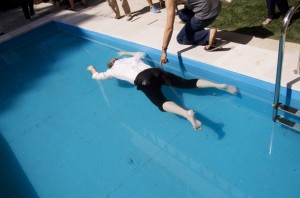
The second building is a mock designer home, a place I’d be jealous to live. Just outside, a wealthy man is lying face down in a pool, murder or suicide, it’s unclear. Inside we piece together as much of the narrative as we want – some people lingered at the desk with the typewriter, others looked at the classic homoerotic drawings by Tom of Finland, while some people just sat in the middle and admired the furnishings. From any angle, “The Collectors” is a type of narrative mystery, but more importantly, a human question, a question for the art world at large asking “what went wrong?” This rhetorical statement was so clearly posed in the forefront of my mind that the rest of the pavilions and works were nearly impossible to contend with. The “why is this here” question was effectively thrown out the window, and instead, a statement with tangible purchase.
As I exited ‘The Collectors,’ I was for the first time genuinely excited about the Biennale. Michael Elmgreen and Ingar Dragset’s masterful and seamless site-specific installation bridging two buildings and more than a dozen artists working together to construct the type of experience that we just don’t see enough of in the art world. Neither narrative or excerpt, ‘The Collectors’ is a gem that the art world can exclusively call its own.
If “The Collectors” is any indication, then the Artist-Curator is here to stay. Elmgreen and Dragset, the dynamic duo orchestrating the installation, actively engaged the physical space at the gardens and aimed to break down the curatorial barrier. It was the first and only project in Venice that genuinely encouraged an exclusive relationship between the viewer and the piece, no stupid nonsense about what the piece is trying to do via the curator or printed matter (see German pavilion.). No use of the art world’s “f” word (framework – see Finish pavilion.) to tell me how I should be looking at it. And an outright rejection of nationalism as an important aspect of the artist’s work (see any pavilion. from a country you never even considered to be on the contemporary art map unless they have cultural cues to validate them including Venezuela, Egypt, Morocoo, Brazil etc.).
Pitting Birnbaum’s Fare Mondi // Making Worlds against such a fresh collaborative work as “The Collectors” is probably the most concise way to see just how conservative and tame the Making Worlds prompt really is. Birnbaum (and most of the other pavilions) asks us to search for the making of a world as some sort of end goal. This experience for me personally is akin to the first time I really understand what Pierre Bonnard was trying to do with his Mediterranean paintings – the wonderful epiphany of seeing dark purple in a blisteringly hot afternoon. But this is what we have been doing since Les Demoiselles d’Avignon (and perhaps even longer). This is now a very familiar process to the art community. ‘The Collectors’ is not concerned at all with this sort of revelation. Instead of asking us to discover a new perspective, to find a new world, ‘The Collectors’ throws us into the thick of things and calls us into action. Here we take part in a world and make our own discoveries… no hand holding allowed.
At its best and most shocking, the created world is a platform, a beginning not an end. And while the rest of the art work at Venice was impressive, some of it astoundingly good, most of it seemed out of place and out of time. The drowned collector is a great metaphor, not only for the art market, but for many other roles in the art world – a real sense of panic. Fumbling forward, the art world should feel lost, but enthusiastically so and ‘The Collectors’ is a saving grace, a confident cartwheel forward amidst a sea of mumbles and back-pedalling.
Elmgreen & Dragset: The Collectors at Venice Biennial 2009 / Video Interview with Ingar Dragset (Vernisagge TV)
Venice Preview: Elmgreen & Dragset (Interview Magazine)
AO On Site – Venice Biennale: ‘The Collectors’ at the Danish and Nordic Pavilions and ‘Making Worlds’ at the Venice Biennale (via ArtObserved)


